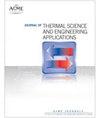人工智能在不同纳米流体和混合纳米流体中浮力比对MHD双扩散混合对流和熵产影响预测中的应用
IF 1.4
4区 工程技术
Q3 ENGINEERING, MECHANICAL
引用次数: 0
摘要
本文研究了在磁场作用下,不同浮力比对带两个旋转圆柱体的盖子驱动的梯形壳体内混合对流和熵形成的影响。分别研究了swcnts -水、cu -水和al2o3 -水纳米流体的效果,以及三种不同类型的swcnts - cu - al2o3 -水混合纳米流体的效果。采用Galerkin加权余量有限元法求解控制Navier-Stokes方程、热能方程和质量守恒方程,得到不同参数值下箱体内的平均努塞尔数、Sherwood数、温度和Bejan数作为输出参数。然后,利用仿真数据建立了一种新颖的人工神经网络模型进行有效预测。通过有限元法和人工神经网络分别得到各输入参数的最优值,并将有限元法和人工神经网络进行对比研究,得到输出参数的最佳结果。利用cu - al2o3 -水混合纳米流体对新场景下建立的人工神经网络模型的性能进行了评估。提出的创新人工神经网络模型以更少的时间和足够的精度预测每种类型的研究控制流体的结果。在训练和验证数据上,该模型预测对流传热传质、平均无因次温度和贝让数的准确率分别为96.81%和98.74%。在测试数据上,对流传热传质精度为97.03%,平均无因次温度和贝让数精度为99.17%。本文章由计算机程序翻译,如有差异,请以英文原文为准。
Application of Artificial Intelligence on Predicting the Effects of Buoyancy Ratio on MHD Double-Diffusive Mixed Convection and Entropy Generation in Different Nanofluids and Hybrid-Nanofluids
The present computational investigation aims to investigate the effect of varied buoyancy ratio on mixed convection and entropy formation in a lid-driven trapezoidal enclosure under magnetic field with two rotating cylinders. The effects of SWCNT-water, Cu-water, and Al2O3-water nanofluids individually, as well as effects of three different types of SWCNT-Cu-Al2O3-water hybrid nanofluids are examined. The governing Navier-Stokes, thermal energy, and mass conservation equations are solved using the Galerkin weighted residual finite element method to obtain results as average Nusselt number, Sherwood number, temperature, and Bejan number as output parameters inside the enclosure for different parameter values. Then, an innovative artificial neural network model for effective prediction is created using the simulation data. The optimum values of each of these input parameters are obtained by FEM and ANN, and a comparative study between FEM and ANN is done to get best results for the output parameters. The performance of the created ANN model for novel scenarios is evaluated using Cu-Al2O3-water hybrid nanofluid. The proposed innovative ANN model predicts the findings with less time and sufficient accuracy for each type of studied governing fluids. The model's accuracy for predicting convective heat and mass transfer, along with average dimensionless temperature and Bejan number, was 96.81% and 98.74%, respectively, when tested on training and validation data. On test data, the accuracy was 97.03% for convective heat and mass transfer and 99.17% for average dimensionless temperature and Bejan number.
求助全文
通过发布文献求助,成功后即可免费获取论文全文。
去求助
来源期刊

Journal of Thermal Science and Engineering Applications
THERMODYNAMICSENGINEERING, MECHANICAL -ENGINEERING, MECHANICAL
CiteScore
3.60
自引率
9.50%
发文量
120
期刊介绍:
Applications in: Aerospace systems; Gas turbines; Biotechnology; Defense systems; Electronic and photonic equipment; Energy systems; Manufacturing; Refrigeration and air conditioning; Homeland security systems; Micro- and nanoscale devices; Petrochemical processing; Medical systems; Energy efficiency; Sustainability; Solar systems; Combustion systems
 求助内容:
求助内容: 应助结果提醒方式:
应助结果提醒方式:


